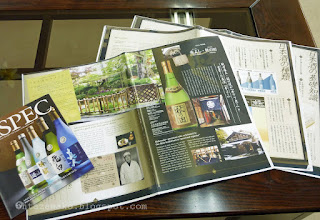Did you know that sake is enjoyed best fresh, unlike grape wine that is generally considered that it 'ages' well. Generally, 'aged sake' simply means that it is old and not fresh.
(Read pt.1)
In this sake brewery tour at Hideyoshi's brewery, Suzuki Shuzoten, our guide, Mr. Saito has told us so many interesting stories to deepen our understanding of sake brewery technique. The end of our tour was what we were waiting for - tasting the sake!
In the English written material, a writer describes Hideyoshi as follows:
ACCESS TO HIDEYOSHI'S SUZUKI SHUZOTEN:
Suzuki Shuzoten is located in Nakasen area in Daisen City, Akita Prefecture. From Tazawako, you need to take a local train ("Tazawako-sen") for 40 minutes and take off at JR Ugo-Nagano Station (after Kakunodate). The brewery is within 10 minutes walk from the station.
Taking a public transportation is highly recommended, unless you have a driver or not trying the sake in the end of tour.
BOOKING THE TOUR:
Reservation on this tour is required. Make sure you contact them at least 2 days advance. E-mail at info@hideyoshi.co.jp
Also, this helps especially if you are non-Japanese speaker. So the guide can prepare somesome English materials to help your understanding, because there is no English guide available. (Still, the Japanese guide will try to explain with simple English terms.)
AVAILABLE OVERSEAS:
If you are interested in Hideyoshi's product but not planning to visit anytime soon, you might still find a bottle from foreign distributor such as American Winebow. Inc.
LEARN MORE ABOUT AKITA'S GREAT SAKE IN USA?
Check out some event information on Japan America Society of Southern California and Bishu Oukoku Akita no Kai (based in New York).
(Read pt.1)
In this sake brewery tour at Hideyoshi's brewery, Suzuki Shuzoten, our guide, Mr. Saito has told us so many interesting stories to deepen our understanding of sake brewery technique. The end of our tour was what we were waiting for - tasting the sake!
"Kaoru" Junmai Daiginjo, the Premium Sake from Hideyoshi.
This is one of the sake we tasted: Shousei, A Junmai Ginjoshu
You are given this packet with so much information to understand the sake culture!
You can learn about Hideyoshi's Toji-san, as well.
The difference in taste of each bottle is apparent. Each type has different texture and aroma. If you are a beginner who thinks all the sake taste the same, here is your chance to learn it in an experience. The guide also gives you a great advise in choosing your favorite type of sake. Ask them anything.
In the English written material, a writer describes Hideyoshi as follows:
Jurin is particularly a unique kind. It is shochu made of rice especially produced by this company. Most commonly, shochu is known as a distilled beverage made of barley or potatoes, but here at Hideyoshi’s Suzuki Shuzoten you can try a shochu of rice! The aroma is given by an oak barrel that used to be used for whisky brewering; yet, the taste has mildness and sweetness from Akita rice Imagine a light whiskey but not watered down.Fruity Fragrance mixed with a fresh herbal aroma. It begins on a light, smooth note, and then later develops a cristp richness, which a lingering after taste.
Jurin is a shochu made of rice!
Large bottles of sake.
The one on the left end is what kurabitos prefer drinking, Mr. Saito said.
More expensive ones are in these golden bottles and displayed.
You can purchase what you liked.
Other products like cakes and ramen noodles!
If you are fond of Nigori, here is a best chance to try it in the best condition. Nigori is mildly filtered sake but with no pasteurization, which leaves the yeast alive. When the bottled Nigori is transported for a long distance (say, shipped overseas), the yeast slowly die. That is why you must try Hideyoshi's nigori at its best here at the brewery.
ACCESS TO HIDEYOSHI'S SUZUKI SHUZOTEN:
Suzuki Shuzoten is located in Nakasen area in Daisen City, Akita Prefecture. From Tazawako, you need to take a local train ("Tazawako-sen") for 40 minutes and take off at JR Ugo-Nagano Station (after Kakunodate). The brewery is within 10 minutes walk from the station.
Taking a public transportation is highly recommended, unless you have a driver or not trying the sake in the end of tour.
BOOKING THE TOUR:
Reservation on this tour is required. Make sure you contact them at least 2 days advance. E-mail at info@hideyoshi.co.jp
Also, this helps especially if you are non-Japanese speaker. So the guide can prepare somesome English materials to help your understanding, because there is no English guide available. (Still, the Japanese guide will try to explain with simple English terms.)
AVAILABLE OVERSEAS:
If you are interested in Hideyoshi's product but not planning to visit anytime soon, you might still find a bottle from foreign distributor such as American Winebow. Inc.
LEARN MORE ABOUT AKITA'S GREAT SAKE IN USA?
Check out some event information on Japan America Society of Southern California and Bishu Oukoku Akita no Kai (based in New York).
.JPG)
.JPG)
.JPG)



.JPG)
.JPG)
.JPG)
.JPG)
.JPG)
.JPG)
.JPG)
.JPG)
.JPG)
.JPG)
.JPG)
.JPG)
.JPG)
.JPG)
.JPG)
.JPG)
.JPG)
.JPG)
.JPG)
.JPG)
.JPG)
.JPG)
.JPG)
.JPG)
.JPG)
.JPG)
.JPG)
.JPG)
.JPG)
.JPG)
.JPG)
.JPG)